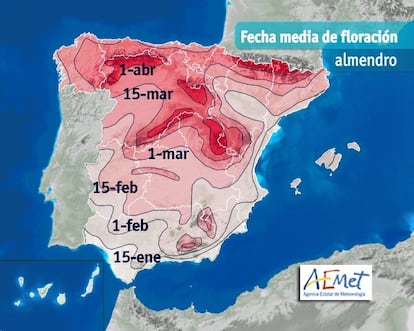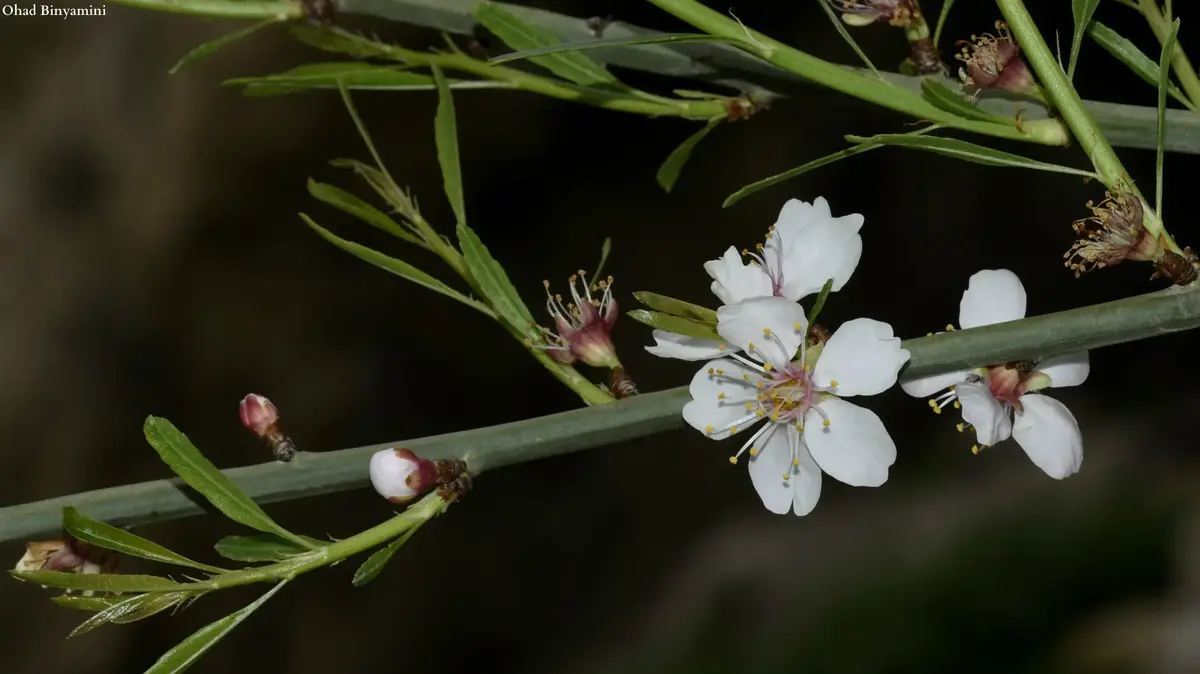A curious walker stops on February 1 in front of some almond trees in the Retiro in Madrid and wonders if it is normal that they are already in bloom.
No, it's early, according to the average dates of the department of phenology - which studies the behavior of animals and plants that occur at the beat of the weather - of the State Meteorological Agency (Aemet).
In much of Spain, the flowering of this fruit tree is also being early, with advances of up to a month over what is considered normal, a phenomenon that has been repeated year after year in recent decades.
The causes, according to experts, are clear: the mild winters caused by climate change.
The consequences are disastrous.
Map prepared by El Tiempo de TVE based on phenological data from Aemet shows the isochrones of the flowering of this tree of the Rosaceae family.
"Time deceives the almond trees," summarizes Javier Cano, head of the Defense Meteorological Office of Getafe, who has spent 40 years writing down in the same points of the capital the date of the hatching of the
Prunus dulcis
, a tree of the family of the rosaceae introduced 2,500 years ago and that heralds spring by being one of the first to appear.
“This year, the first flowers were observed on January 29, nine days earlier than normal.
The past, 11 days, despite
Filomena
”, details Cano.
“The trend from 1981-2022 shows a slight advance”, she concludes, graph in hand.
Of the last 12 years, in five it has been very early, with advances of up to 22 days, and in another two, early.
Historical series of the dates on which the first flowering almond trees were observed in Madrid (period 1981-2022). Javier Cano / Aemet
Also in Madrid, the agronomist Gilberto Segovia, who cares for the specimens at La Quinta de Los Molinos, is convinced that, if they had figures, they would point to "a trend towards progress in the last 50 years."
"This year is a couple of weeks, a lot, because the winter has been laughable," he notes.
Segovia notices a poorer flowering, with a smaller size, which will make pollen production less.
More data.
The Fenocat network of the Meteorological Service of Catalonia has one of its targets in this tree, with 25 data collection points since 2013. Xavier de Yzaguirre, Fenocat technician, clarifies that, at the moment, they have no conclusions, since series are necessary 30 years old.
They can provide evidence at one point, Tivissa (Serra d'Almos, Tarragona), where the observer Josep Borrel has been collecting data from his orchard since 1971.
There, the average temperature has increased 1.7º and the series reveals that the largueta variety constantly anticipates its flowering ―15 days in 50 years―, while the ferragnes accumulated four days per decade, but the last five have stagnated.
De Yzaguirre warns that it depends a lot on the variety – early or late – and on the location.
Graph of the early flowering of the llargueta variety almond tree.Meteocat-Servei Meteorològic de Catalunya
Broadly speaking, the further south and east, the sooner it blooms.
Thus, in the Balearic Islands and Levante the usual date is between the middle and the end of January;
on the southern plateau, in mid-February;
while in colder areas, such as Aragón and Castilla y León, it goes to March;
and in the Cantabrian mountain range, at the beginning of April.
Experts point out that the temperatures and the solstice are decisive.
In autumn, it closes its stomata (pores), isolates itself to defend itself from winter, and enters a state of drowsiness.
“What wakes up his biological clock is a cold
flash
and, for a normal development of the female and male parts to take place, he has to accumulate a certain cold first – between 100-500 hours below 7º depending on the variety. , and heat afterwards”, details Enrique Salvo, botanist and professor of Environmental Sciences at the University of Malaga.
a hot winter
The almond tree, oblivious to calendars, hatches because it has already added all the cold and heat it needs after a mild winter.
“In December, the maximums were 1.9º higher, while in January they were the highest since there are records, 2.1º higher.
There has also been a lot of thermal contrast, again the greatest in history, because the minimums were cold, 0.7º below the average.
February follows this trend, with a start with values of April and these days, of May”, details Rubén del Campo, spokesman for Aemet.
The meteorologist highlights the progressive
springtime
of winters, “a clear consequence of global warming”.
Of the last six, only one has been cold, and the rest have been warm—three very hot and one extremely hot.
Flowers on the ground in the Quinta de los Molinos (Madrid), on the 11th.Aitor Sol
Climate change experts consider it a “traffic light” species, since these “significant alterations in its phenology cause alarm bells to go off”, in the words of Salvo.
“What is happening to him is not normal.
It is the closest and most immediate indicator of climate change that we can best observe, ”he says.
This botanist studied it in the Guadalhorce and Guadalmedina valleys, the Sierra de las Nieves, the Axarquia
,
Seville and Cordoba.
His conclusion is that “a very significant and constant advance is taking place”.
This year in Guadalmedina they bloomed at the end of December, “almost a month earlier in a decade”.
"The same thing is happening in the five biomes with a Mediterranean climate," he warns.
In the Balearic Islands, "the perception is in advance", although nobody is monitoring it, says Jeroni Galmés, professor of Plant Physiology.
Galmés also has no doubt that "it is part of the effects of climate change, which alters environmental conditions and causes the tree to change its hormonal pattern."
It does not happen, far from it, only to the almond tree: advances of 20 days in two decades have been documented in the olive tree, highlights the biologist.
"There are models that try to predict its impact in each bioregion and suggest that it will move north in search of suitable climatic zones", since it will not be cold enough in the south, Galmés warns.
Spain is the largest producer in the EU with more than 718,000 hectares, of which 638,000 are rainfed, with Andalusia, Castilla-La Mancha, Aragón and Catalonia as strongholds.
Now, the great fear is that the fruit will be lost due to late frosts, which can even occur in May.
To tackle these problems, genetic research is being carried out in order to achieve varieties that flower in May and that are capable of adapting to increasingly higher temperatures.
Field of almond trees in bloom, the first week of February in Sant Feliu de Llobregat (Barcelona). Xavier de Yzaguirre
Another pernicious effect is the lack of synchrony with pollinators, so production can be reduced.
"Bees are caught when they are old instead of when they are most active and efficient, and this tree needs cross-pollination, strong young individuals that can carry pollen and travel a certain distance," says Salvo. .
It can also affect the quality of the fruit and its cover, which is sold as pellets and is "losing thickness", which reduces its energy properties and exposes the fruit to inclement weather, fungi and bacteria.
The xylella fastidiosa has produced a "mass mortality" in the east and center of Mallorca, laments Galmés.
They also highlight the consequences of the drought, which affects the ability to produce sugar and transport it to the almonds.
“It is the modern version of the almendruco trick.
During Holy Week, in which cow's milk could not be drunk, almond milk was taken.
If it fell early, what was collected was almendruco, with a high concentration of amygdalin, which gives it a great bitterness, so honey had to be added.
Now, the phase of the almond tree is expanding, the fruit does not ripen as it should”, warns the professor from Malaga.
"It's a disaster for farmers," he says.
According to the National Table of Nuts, last year ―with a winter at 0.7º above average and early sprouting― production fell by 12%, where more in the Balearic Islands, half.
“There were frosts on the San José bridge and many almond trees were taken away.
This year, everything depends on the next two or three weeks”, says José Ugarrio, Asaja coach.
"There seems to be a clear trend towards earlier blooms around the world - last year cherry trees in Japan experienced their earliest blooming in 1,200 years - and that is a consequence of global warming, but further studies of its causes and consequences”, concludes the meteorologist José Miguel Viñas.
You can follow CLIMA Y MEDIO AMBIENTE on
and
, or sign up here to receive
our weekly newsletter
Exclusive content for subscribers
read without limits
subscribe
I'm already a subscriber




/cloudfront-eu-central-1.images.arcpublishing.com/prisa/GE2HIPPGSREYXNPF3G7BWKT62U.JPG)

